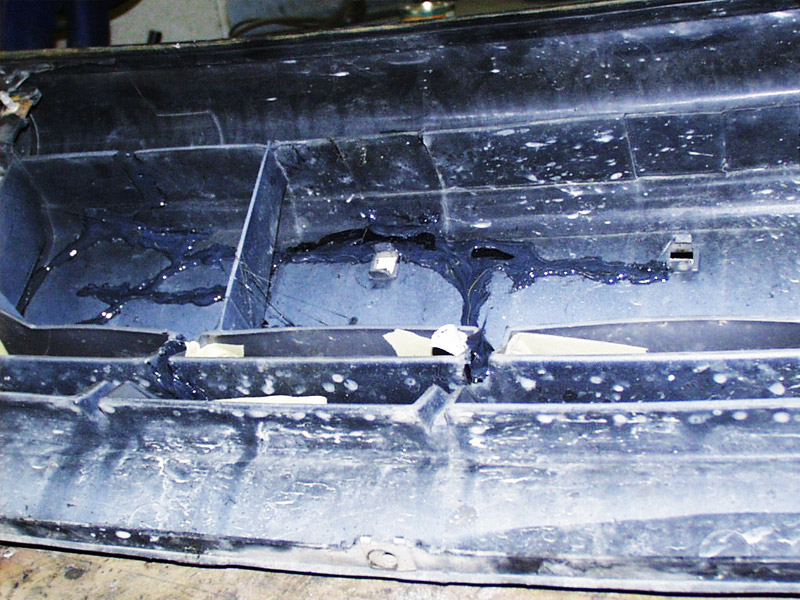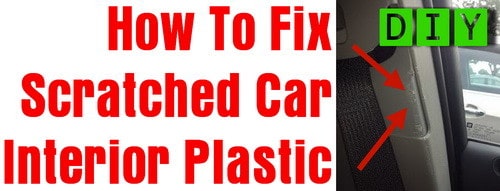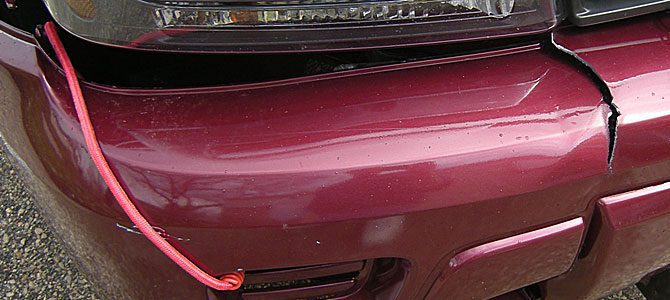When the repair is completed, apply two wet coats of flexible part sealer. After drying for 30 minutes, the fascia is ready for priming and painting. Prime the fender with two coats of any two-part primer-surfacer, making sure to let the primer dry between coats.
Once the primer has hardened, dry sand the repaired areas with 400-grit paper to level it and remove any imperfections. You may need to repeat this process two or three times to cover completely. Once the base coat is dry , mix the clearcoat with hardener. Apply two medium clearcoats, allowing each to dry in between. After drying overnight, the fascia is ready to be reinstalled. If the crack is in a flat area on the bumper, the repairs are fairly simple and require less time and material – meaning they are likely to cost less, too.
But, when the damage involves a vehicle's style lines, curved areas or molded sections around lights or intakes, it's a different story. Repairs to these special areas require additional care which translates to more time and more resources – usually meaning more money. That's why a professional auto body shop provides a detailed cost/benefit analysis for each job. While in most every case, a plastic bumper crack repair us possible, it some it isn't practical. Now your repair is finished, it's time to prime and paint the bumper. You'll need proper bumper primer and paint that is flexible enough for plastic, otherwise it may crack and flake.
You will also need to apply a clearcoat over the finished paint to keep it in good condition and prevent more damage. Apply at least two coats of each, primer, paint and clearcoat, allowing to dry fully between coats. Note that plastic bumper repair kits don't come with paint or finishes, but may contain primer.
Minor issues can usually be repaired, but more serious damage could require a new replacement bumper. The choice between bumper repair or replacement will come down to the extent of the damage. Typically minor scratches, dents and chips can be easily repaired using specialized tools found in an auto body shop. Nearly every cracked plastic bumper can be repaired, and usually for less than half the cost of a new bumper. While almost every cracked bumper can be repaired, it isn't always practical.
A plastic bumper crack repair job requires a special plastic welding technique plus the application of structural adhesives. During the process, body paint is blended to match the original color. The finished job provides a seamless, invisible repair. We've all been there–hastily putting the car in reverse, failing to check the blind spot, and cringing at the crunch of the bumper meeting barricade.
In best efforts to save some money by using a bumper repair in montreal repair professional. But if your car meets the sharp edge of a 2-foot parking barrier, the semi-flexible plastic can easily be scratched, ripped, bend, or break. Again, read the labels and follow the maker's recommendations for operator safety—this stuff can be very toxic if inhaled.
Modern primers and basecoat/clearcoat paints are flexible enough to accommodate plastic bumpers without peeling or loss of adhesion. Once the exterior filler material is completely dry, you need to sand it flush with the rest of the bumper. Affix the 200 grit sandpaper to the sanding block and sand the whole area of the crack until the filler compound is flush with the rest of the bumper. Completely remove all dust and grit from the bumper surface and carefully use the touch up paint to paint over the area of your repair of the plastic bumper.
A plastic bumper repair is an easy weekend body repair job to help beautify your car by getting rid of deep scratches and cracks. One option for this type of repair job is to use a fiberglass body repair compound such as Bond-O. However, there are a number of companies that produce a plastic bumper repair kit. Listed below you will find a listing of tools and materials that you will need and the steps required for plastic bumper repair.
The shop will also repaint or blend any repaired areas on the bumper to make sure it is an exact color match to the rest of the vehicle. If an auto body shop repairs your cracked bumper, expect to pay between $350 and $600. The cost to fix a cracked bumper will depend on two things. Certain metallic car paint colors are even more expensive.
If the bumper needs replacement, it will cost between $1000-$1500 depending on the make and model. Bumper scratches and scuffs are unsightly, and alarmingly easy to get. You don't have to cover your car with hard-to-remove bumper stickers to make it look better, however. Fixing damaged plastic bumpers involves grinding, sanding, sculpting and painting. But it's worth the effort for repairs that would cost less than your deductible. Fortunately for your bruised bumper, plastic repair and refinishing materials are widely available and reasonably simple to use.
When we advise our customers in regards to bumper repairs we always advise them to get their supplies at their local Canadian Tire. Car bumper touch up's are an easy DIY project to keep your car looking brand new. Just remember that this is not a great method for extensive paint damage. If your vehicle has severe paint damage we recommend bringing your car to a professional repainting service shop. Not all paint repair jobs need an auto body shop, as there are things worth doing on your own. It is also worth noting that paint damage can lead to rust and corrosion eventually.
Cracked plastic bumpers are a reality in today's vehicles. When a plastic bumper gets scuffed, dented or cracked not only does it look bad, it reduces the value of the vehicle. Plastic bumper repair is one of the most demanded body shop services and drivers are often totally unaware of how affordable it is to repair a plastic bumper. Auto Color provides plastic bumper crack repair services for every make and model vehicle.
Scratches happen, but shallow ones that don't go all the way through the paint are easily eliminated with buffing. This goes for shallow scratches anywhere on your car, not just bumper covers. Any auto body shop or detailing center can buff out scratches for you, and this often works well. You can also buff yourself using an electric automotive polisheralong with the finest grade of auto polishing compound. Random orbit woodworking sanderfitted with a buffing pad also works great as a polisher. We've all been there --hastily putting the car in reverse, failing to check the blind spot, and cringing at the crunch of bumper meeting barricade.
But if your car meets the sharp edge of a 2-foot parking barrier, the semi-flexible plastic can easily rip, bend, or break. Ordinary touch up paint will just flake off. Remember, bumper covers are designed to flex when they hit something. Automotive touch up paint doesn't flex unless it contains a special "flex" additive.
You can buy that kind of paint at an autobody paint store and have them pump it into spray cans. But do you really want a "rattle can" paint job? Also, many bumper plastics require a pre-treatment with an adhesion promoter before painting. If you skip this step, the paint won't stick.
With a plastic bumper repair kit, this will be a wire mesh that is "welded" into the plastic of the underside of the bumper and gives strength to the repair. With a Bond-O type kit, this will be an adhesive wire, fiberglass or plastic mesh. If you are using the kit, you will need to use the soldering iron type tool to heat the wire mesh and plastic to embed the mesh in the plastic. The Bond-O kit will have the mesh applied to the surface. Many plastic bumper parts can be repaired, especially bumper covers, which are commonly damaged on a vehicle. In addition, a plastic bumper repair can be reliably carried out whether it's a thermoplastic or thermoset bumper, which will depend on your vehicle.
If you are just talking about a few small chips or scratches, repairing them may be a fairly quick and easy job for an auto paint repair specialist. Some chips might be fixable using spot repair tactics, by repainting and sanding the area before applying a clear coat. If you were not at fault, you can contact the other driver's insurance company to claim the bumper repair or replacement costs. After the solvent has dried, sand the area by hand with 80-grit paper.
Next, you'll need to form a "V" groove in the damaged area on the front and back sides of the fascia. The grooves allow you to align the two edges more easily. They also provide more surface area for the repair material to adhere to. For plastic types that powder when sanded , cut the grooves with a 24-grit disc on a sander.
For plastics that smear when sanded , make the grooves using a cordless drill and a rotary file. Most bumper repair kits are suitable for most types of plastic bumpers. It is impossible to apply too thick layer of putty, it will not hold and will fall off. If there is too much recess or hole, repair the bumper with mesh. That is, first, a special mesh or fiberglass is glued, then putty is applied to the bumper at the place of repair.
This mesh helps keep the putty from cracking. If it is necessary to apply a thick layer of putty, more than 5 mm, even when laying the mesh, it is better to apply it several times. Each subsequent layer is applied only after the previous one has completely hardened.
At the very end, after the putty has dried, the surface is cleaned and smoothed with fine sandpaper. In addition to sealing, you can also glue cracks on the bumper. For this you can use epoxy resin or any other glue for plastic. Special glue for repairing a car bumper is also sold in stores. Such glue will adhere better and will not crack for a long time.
How To Repair Peeling Paint On Plastic Bumper Some car enthusiasts also use super glue and soda for bumper repairs. In this case, glue and soda are applied alternately in thin layers, it is advisable to apply at least 5-6 layers, at intervals of several minutes. This connection allows you to create a material similar in density to plastic.
If the bumper is repaired with epoxy glue, then you need to mix the base and hardener in a certain proportion according to the instructions. Bumpers take the majority of the wear and tear on our vehicles. To blend the new touch-up paint with the old one, you need to do paint feathering. Feathering is when you apply a paint in such a manner that no definite edges are visible. To make the damaged panel blend in with the surrounding auto body panels start by spraying the damaged area first.
With each coat of paint spray a little farther away from the damage. The goal is to lightly spray with feather coats of paint adjacent area to blend in the repair area. This technique also can help create a smooth transition if the new paint is not perfectly matching the old one. Getting cracks in plastic bumpers is a customary incident.
While cars equipped with plastic bumpers are liable and tend to get cracks even in small accidents. When the car's bumper gets scratched or cracked, you either need to repair the bumper or replace it. If the damage is not severe, then repairing is the best solution.
The Process– Cracks are small fractures or splits in the car exterior without any major breakage. As long as the cracks are strictly the exterior plastic, Bumper Buddies will fix it! First we clean the damaged area with a surface cleaner and smooth out the damage. We will then fill it with a plastic filler that will match your car's exterior material.
After the filler dries, we'll sand it down and smooth it again before painting with PPG paint, which is water-based and environmentally friendly. Your car bumper is looking just like new again and no one would even know the crack was there. Patching can save you money, compared with complete bumper cover replacement, and it's an approach that's DIY friendly, too. Once the material has hardened , move to the front of the fascia and remove any tape . Next, using 80-grit sandpaper, remove any material that has squeezed through, and sand any spots that are above the finished level of the fascia.
Fill the cut or tear and any low spots in the front of the fascia with the appropriate repair material, and squeegee it level. Then finish sand with wet 400-grit paper. Some plastic bumper repair kits come with primer. If not, the finish, paint and primer will need to be purchased separately. A clearcoat is also highly recommended as it will ensure the finished paint remains in good condition and will prevent any further damage. Just because you have a cracked bumper on your car doesn't mean you need to replace the entire thing.
Knowing how to fix it can save you hundreds. If you're able to close the crack's gap on your bumper, you can attempt this repair yourself. This article and video covers how to do your own plastic bumper repair with a fiberglass repair kit and tips from our expert mechanic, Andy. If you want to repair scratchy plastic bumper scars and scrapes yourself, a DIY kit can be an excellent idea.























No comments:
Post a Comment
Note: Only a member of this blog may post a comment.